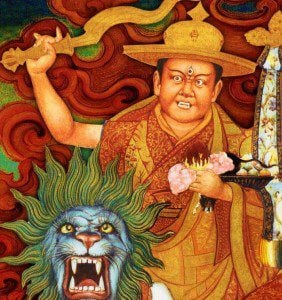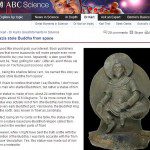Last week the Dalai Lama made a three-day visit to Oslo, Norway, where he received the Nobel Peace Prize 25 years ago for his ongoing nonviolent stance toward China, which took over Tibet between 1951 and 1959. And while thousands of well-wishers turned out to greet the Dalai Lama, a small band of protesters were also on hand, asking for the prize to be revoked.
The protesters were, by and large, members of the New Kadampa Tradition, a break-away group from the Dalai Lama’s Geluk tradition. Such splits and new traditions are not unheard of in Tibetan Buddhism, which has never had any formal and fixed hierarchy. Even the commonly held division of “4 schools of Tibetan Buddhism” is just a convenient designation, masking a vastly more complex doctrinal and historical reality. Part of that historical reality has been the need for Tibetan Buddhists in exile to work more cooperatively together and one impediment to this, according to the Dalai Lama and others, is Dorje Shugden.

Dorje Shugden is a controversial ‘protector deity’ for the Geluk tradition. On the surface that is benign enough, and there are similar protector deities still accepted in that and other traditions of Tibetan Buddhism. Yet, as Georges Dreyfus, a preeminent scholar of Tibetan Buddhism, notes:
“There is, however, another element that must be examined in order to understand the troublesome nature of the practice of Shuk-den, namely, the sectarian stance that it reflects. This is where the story of Drak-ba Gyel-tsen becomes relevant again. For Pa-bong-ka, particularly at the end of his life, one of the main functions of Gyel-chen Dor-je Shuk-den as Ge-luk protector is the use of violent means (the adamantine force) to protect the Ge-luk tradition. Pa-bong-ka quite explicitly states:
Now [I] exhort to violent actions Shuk-den, who is the main war-god of Dzong-ka-ba’s tradition and its holders, the angry spirit, the Slayer of Yama (i.e., Yamantaka or Manjushri in his wrathful form)….In particular it is time [for you] to free (i.e., kill) in one moment the enemies of Dzong-ka-ba’s tradition. Protector, set up [your] violent actions without [letting] your previous commitments dissipate. Quickly engage in violent actions without relaxing your loving promises. Quickly accomplish [these] requests and entrusted actions without leaving them aside (or without acting impartially). Quickly accomplish [these] actions [that I] entrust [to you], for I do not have any other source of hope. [40]
This passage clearly presents the goal of the propitiation of Shuk-den as the protection of the Ge-luk tradition through violent means, even including the killing of its enemies.
Thus, in 1997, the Tibetan Parliament in Exile passed a resolution discouraging the worship of Shugden and encouraging greater education on its demerit in the context of building greater Tibetan unity in exile. Since then, those who have insisted on Shugden worship have continued their efforts for what they consider a matter of religious freedom.
The following is their account from last week’s visit and protests:
https://www.youtube.com/watch?v=1YmeQV9viAg
Robert Thurman, another leading scholar of Tibetan Buddhism, responded to the planned protests in the Huffington Post, writing in part that:
The worship of their chosen deity was not “banned” by the Dalai Lama, since he has no authority to “ban” what Tibetan Buddhists practice. “Banning” and “excommunicating” are not Tibetan Buddhist procedures.
…
The whole fuss would have died down long ago except for the fact that the “hard-line” operatives of the “United Front Work Department” of the People’s Republic of China, the agency in charge of dealing with China’s “minority nationalities,” sees the cult as a potential wedge they hope to drive between the Dalai Lama and his people and between him and world opinion.
Whatever one believes about the reality of fierce angels or demons, it is clear that the leaders of the Dolgyal Shugden cult have done nothing over the last 30 years but cause trouble, both to their own followers and to the unity of the Tibetan people, both in exile and in Tibet. It has benefited no one except those misguided operatives in the Chinese government who wish to destroy Tibetan Buddhist culture, in order to assimilate systematically deracinated Tibetans into becoming second class Chinese citizens, and thus, through such a policy of crushing the identities and even lives of the “minority nationality” Tibetans, to secure forever their claim to the vast territories and resources of the Tibetan plateau.
And so the fuss does go on. Oddly enough, many within the New Kadampa Tradition (NKT) themselves are only vaguely aware of this controversy or others within that tradition. A post I put up three years ago pointing out the New Kadampa Survivors group still gets a number of “thank you” and “I had no idea….” responses. Help spread the word. Buddhists, both inside and out of the NKT need to understand the history of Shugden and his role in Tibetan Buddhist practice and politics.
This 1998 BBC documentary provides good background to the Shugden controversy and the NKT:












